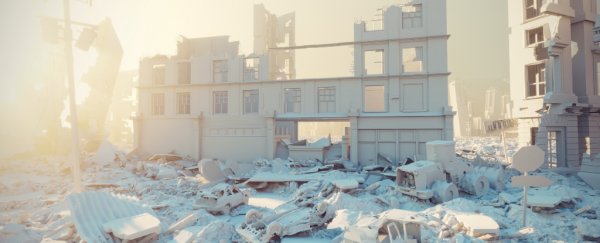With the Cold War over and our future on fire, few of us devote much thought to nuclear winter in today's world. Rutgers University climatologist Alan Robock is an exception. He still thinks about it. Quite a lot, in fact.
Robock worked with a small team of fellow environmental and atmospheric scientists to double check previous sums on just how bad a hypothetical nuclear winter could get. The result? Pretty terrible for all of us, no matter where you are.
According to his calculations, if all of Russia and the US's nuclear weapons were used in a conflict today, we could expect a shocking drop in global temperatures, less precipitation, and a lot less food to go around.
In this hypothetical mother of all wars, nuclear particles would be transported between the hemispheres within two weeks. Global temperatures would then plunge by around 9 degrees Celsius over the next 12 months. Depending on the modelling, this decline could continue another 1.5 degrees Celsius.
This is an average, don't forget. In many places across Europe and North America, even summer will be a frozen hellscape some 20 degrees Celsius colder than it is now, at least for a few seasons.
Those who survive by bunking down and rugging up for five or six years will then need to worry about starvation.
Not only would a rolling winter limit plant growth, aerosols in the atmosphere could cause an average 30 percent drop in precipitation around the planet within the first few months. Within several years it could drop even further, by between 47 and 58 percent.
But let's take a step back and talk about what kind of war might trigger such a dramatic nuclear winter in the first place.
For the purposes of this model, Robock assumed the US and Russia unleashed all their stockpile of nuclear weapons.
And that's not something that's totally unimaginable. In the early 1980s, towards the end of the cold war, the idea that the US and the Soviet Union might lose their cool and send a barrage of intercontinental nuclear weapons flying around the globe was not just a terrifying possibility, but an increasing likelihood.
While most people feared the devastating blasts and the radioactive fallout, an American atmospheric scientist by the name of Richard P. Turco was more concerned about the clouds of debris blown into the upper atmosphere.
Turco is the one who came up with the term nuclear winter – the cooling of the planet's surface under a pall of fine dust, ash, and soot left by the intense bombing of multiple cities.
He and his team's research was the first to show how smoke injected into the upper troposphere by urban fires could affect climate over a wide area. Any particles that make it as far as the stratosphere would have an express around-the-globe ticket, potentially leading to even more catastrophic climate change.
The idea was solid, but ironing out the exact details would require accurate climate models.
Over the decades, climatologists have returned regularly to Turco's nuclear winter scenario with additional data and sharper mathematical tools to fine-tune predictions on how we'd fair under a post-apocalyptic blanket.
Back in 2007, Robock applied a NASA-formulated atmosphere-ocean circulation model for the first time to determine what might happen if 150 million tonnes of grit was sent sky-high.
Twelve years later, Robock and his team have retested their calculations, pitting their old maths against improved climate models. The good news is those sums more or less predict pretty much the same horror. If that can be called good news.
"This means that we have much more confidence in the climate response to a large-scale nuclear war," says the study's first author, Rutgers doctoral student Joshua Coupe.
The bad news?
"There really would be a nuclear winter with catastrophic consequences," says Coupe.
The result would be the type of scenario described above - mass temperature drops, food shortages.
The real question is, how long would it last?
All of this would depend on the details, of course. Where might the bombs fall? How many would be used? What kinds of time scales are we talking?
While there's room for speculation, some scenarios are more likely than others.
Based on historical war strategies, we can assume far more urban devastation than rural, hitting industries and transport and sending concentrations of soot and other fine particulates into the air.
Robock's newer model optimistically has temperature recovery beginning within five years. Under NASA's climate model, the warming takes a little longer, picking up steam by year seven.
But it would take around a decade for the blanket of cloud that would be scattering and absorbing solar radiation to disperse.
While we all know that a two degree Celsius rise thanks to global warming is one of our most pressing problems, until the world is completely rid of its nuclear stockpile, catastrophic global cooling under dust-laden skies simply isn't something we can rule out.
Two years ago, the UN convened a conference to negotiate a Treaty on the Prohibition of Nuclear Weapons. So far only half of the fifty nations required as signatories have agreed to its terms. The US isn't one of them.
Winter could still be coming.
This research was published in the Journal of Geophysical Research – Atmospheres.
